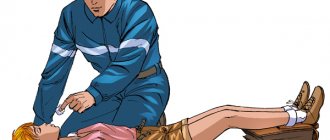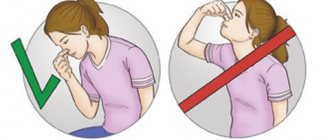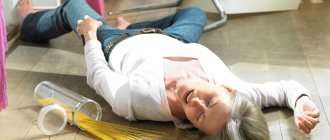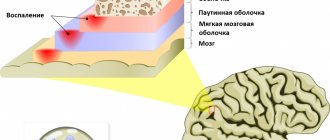Pain in the heart area: causes
Acute coronary syndrome with pain in the heart area is the most dangerous condition. It occurs when a sudden blockage or narrowing of a coronary artery significantly reduces or completely stops the blood supply to an area of the heart muscle (myocardium). The lack of blood supply to any tissue is called ischemia. If the supply is significantly reduced or stopped for more than a few minutes, the heart tissue dies. This is how a heart attack, or myocardial infarction (MI), develops. This is the death (necrosis) of a certain area of cardiac tissue due to ischemia.
A blood clot (or thrombus) is the most common cause of blockage of a coronary artery. Typically, the artery is already partially narrowed due to the accumulation of cholesterol and other fatty materials in the artery wall (atheroma or plaque). It may crumble or rupture, releasing substances that make platelets stickier, which encourages clot formation. In about two-thirds of people, the blood clot dissolves on its own, usually within 1-2 days. However, by this time, damage to small areas of the heart has usually occurred.
In rare cases, a heart attack occurs when a clot forms in the heart itself, breaks off, and becomes lodged in a coronary artery. Another uncommon cause is a coronary artery spasm that stops blood flow. Cramps can be caused by stress, taking certain medications, smoking, or alcohol. Sometimes the exact cause of pain in the heart area cannot be determined.
Nitroglycerine
Nitroglycerin comes in the form of tablets, sublingual capsules, injection solution and spray. You can buy a remedy for heart pain without a prescription. “Nitroglycerin” belongs to the class of nitrates, peripheral vasodilators (vasodilators). Nitroglycerin has long been a proven drug for angina pectoris (attacks of chest pain).
The active substance nitroglycerin relieves spasm in the coronary arteries, quickly expanding the walls of blood vessels; improves nutrition of the heart muscle, stimulating blood flow to it; relieves heart pain associated with spasm.
“Nitroglycerin” acts instantly as soon as it enters the blood, and the effect lasts for a long time. To ensure that nitroglycerin is quickly absorbed into the blood, it is placed under the tongue. And after 3-5 minutes the drug for heart pain begins to act. If the first tablet does not help, take a second one.
IMPORTANT!
You should not take more than three Nitroglycerin tablets in a row with an interval of 5-10 minutes.
If the pain in the heart continues, urgently call an ambulance - thrombosis and heart attack may develop. Nitroglycerin is not prescribed for a heart attack with a strong decrease in pressure, for shock, hypotension, pulmonary edema, glaucoma, high intracranial pressure, or allergies to nitrates. Side effects include dizziness, nausea, rash.
Nitroglycerine
Medisorb, Russia
For sublingual and buccal use: relief and prevention of angina attacks;
as an emergency medicine for acute myocardial infarction and acute left ventricular failure at the prehospital stage. For oral administration: relief and prevention of angina attacks, rehabilitation treatment after myocardial infarction. For intravenous administration: acute myocardial infarction, incl. complicated by acute left ventricular failure; unstable angina; pulmonary edema. For cutaneous use: prevention of angina attacks. from 9
5.0 1 review
831
- Like
- Write a review
Types of pain in the heart area
Depending on the specific cause, the patient is bothered by pain in the heart area of various types. They can be isolated, but are more often accompanied by other symptoms that also need to be paid attention to. Based on the type of pain and its location, duration and accompanying complaints, one or another pathology can be suspected.
- Acute coronary syndrome occurs as a result of sudden blockage of a coronary artery (or its branch). This blockage causes unstable angina or the development of myocardial infarction, depending on the location and extent of the blockage. People with acute coronary syndrome usually experience pressure or sharp chest pain, shortness of breath, and fatigue.
- Aortic dissection. Over time, uncontrolled high blood pressure can weaken the wall of the heart's main artery (aorta). It will thin until it eventually ruptures, causing aortic dissection, which is a medical emergency. Aortic dissection usually causes sudden, severe, sharp pain in the chest, neck, throat, or jaw and often a feeling of pressure in the chest that radiates backwards.
- Heart valve damage. The heart has four chambers. The upper and lower chambers are connected by valves with gates that open and close to allow blood to flow in only one direction. If the valves are affected, the flaps become hardened, fused, or leak and do not function properly. The consequences of these valve problems can cause chest pain in the heart area.
- Myocarditis and pericarditis. Chest pain can also be caused by irritation and swelling of the heart (myocarditis) or its outer lining (pericarditis). Inflammation can be caused by infection or as a consequence of a heart attack or heart surgery. Pain from myocarditis or pericarditis is usually sharp, burning and localized in the center of the chest, in the sternum. Typical pain in the heart area when inhaling, against a background of coughing, or when moving. Sometimes it decreases if the patient sits or leans forward.
- Hypertrophic cardiomyopathy (HCM). This is a thickening of part of the heart. When a person has this condition, the heart has to work harder to pump blood in and out of the heart, which can cause dull or aching pain in the chest. They can intensify with stress.
Diagnosis and treatment
When your heart hurts, it is advisable to go to the cardiology department, directly to a cardiac surgeon. Experienced doctors prescribe a thorough examination. First of all, the patient requires an electrocardiogram, bicycle ergometry, and Holter monitoring. Phonocardiography allows you to study heart murmurs, and echocardiography allows you to study the condition of the heart valves and muscles. In addition, patients may be prescribed X-rays, CT scans, or MRI scans of the spine.
Treatment will depend on the diagnosis. To relieve the identified syndrome, manual therapy may be prescribed, although this is not always enough. In some cases, angioplasty or other surgery is required. The features of therapeutic manipulations, as well as drug treatment, are individual in each case.
Dear patients! Remember that only a qualified doctor can make an accurate diagnosis, determine the causes and nature of the disease, and prescribe effective treatment. You can make an appointment with our specialists or call a doctor at home by calling 8-(4822)-33-00-33
Be healthy and happy!
Other causes of chest pain
Pain in the heart area at rest is possible, which is of extracardiac origin, but simulates cardiac pathology. These may be problems with the lungs (thromboembolism of the branches of the pulmonary artery, pneumonia, cancer) or damage to the intercostal muscles, costal cartilages (costochondritis), osteochondrosis. Then there will be pain in the ribs, especially when breathing deeply, aching or stabbing pain, malaise or weakness. With thromboembolism, breathing problems, severe shortness of breath, increasing dizziness, and a feeling of lack of air occur.
It is not easy to recognize these pathologies, therefore, if any pain appears in the chest area, especially in the left shoulder blade, in the chest area, above the heart area, you should immediately call an ambulance or consult a doctor.
How does “non-cardiac” pain feel to the left of the sternum?
Let's look at the main causes that mimic heart pain.
Intercostal neuralgia, osteochondrosis
With intercostal neuralgia and osteochondrosis of the thoracic spine, the appearance of pain is more often associated with hypothermia, sudden lifting of weight, prolonged uncomfortable body position, bruise of the chest (rib fracture). They can be very intense (to the point of tears). They intensify with a deep breath, with the slightest movement of the body. During palpation, the most painful place is detected along the rib or near the spine.
Pleural involvement
The pleura is damaged by chest trauma, is involved in the inflammatory process against the background of lobar pneumonia, and reacts with effusion in allergic manifestations.
Compare the left and right sides: on the left, pleural plaque covers the lower ribs
The most severe damage is contamination of the pleura with malignant metastases from the tumor. The pain is constant, quite severe, and is associated with coughing and breathing.
Neurosis
Cardioneurosis is characterized by other signs of unrest: increased sweating, agitation, hand tremors, insomnia. The pain to the left of the sternum is dull, constant or stabbing in nature and is not relieved by heart medications.
They are more often observed in emotional women or in strong people who strive to maintain apparent calm.
Diseases of the stomach and pancreas
Diseases of the digestive system, as a rule, have, in addition to pain, other manifestations: heartburn, nausea, bloating, vomiting, and broken stools. Pancreatitis is characterized by a girdling direction of pain.
There is always a connection with the timing of meals and non-compliance with the diet.
Symptoms for which you need to call an ambulance
The manifestations of different types of acute coronary syndrome are similar, and it is often impossible to distinguish between angina and heart attack based on symptoms alone.
The symptoms of angina are quite typical. People usually experience an attack of pressing, squeezing pain under the shoulder blade or behind the sternum. People often interpret this sensation as discomfort or heaviness rather than pain. Discomfort may also occur in the shoulder or on the inside of either arm, spreading through the back into the throat, jaw or teeth. However, in people with unstable angina the picture changes. Attacks of pain occur more frequently or more severely, or attacks occur at rest or after light physical activity. About two out of three people who have a heart attack experience unstable angina, shortness of breath or fatigue in the days or weeks before. This change in chest pain patterns can lead to a heart attack.
With a heart attack, the most recognizable symptom is usually pain in the middle of the chest, which may spread to the back, jaw, or left arm. Less commonly, the pain spreads to the right arm. The pain of a heart attack is similar to that of angina, but is usually more severe, lasts longer, and is not relieved by rest or nitroglycerin. Less commonly, the pain is felt in the abdomen, where it may be mistaken for indigestion, especially because burping may provide partial or temporary relief.
For unknown reasons, women often experience atypical symptoms that are less likely to be accurately diagnosed as a heart problem. About a third of people who have had a heart attack do not experience chest pain. Typically these include women, people over 75, those with heart failure or diabetes, and those who have had a stroke.
Other symptoms of an attack include feeling lightheaded or faint, sudden heavy sweating, nausea, shortness of breath, and fast heartbeat (tachycardia).
During a heart attack, a person may become restless, anxious, sweat profusely, and may experience a feeling of impending doom. Lips, hands or feet may turn slightly blue. During the first hours of a heart attack, a heart murmur and abnormal heart sounds can be heard with a stethoscope.
Stitching heart pains
A sudden, sharp stabbing pain in the heart is one of the most striking signs of a heart attack, which often leads to a heart attack. You should urgently call an ambulance if the pain radiates to the left arm, neck, lower jaw and back. However, pain has the same character when:
- pericarditis or inflammation of the heart membrane;
- cardiomyopathy;
- neurosis, the localization of which is near the heart;
- coronary spasm, characterized by impaired circulation of the heart vessels.
How is diagnosis carried out in patients who often experience heart pain?
An ECG is the most important initial diagnostic procedure for frequent chest pain. Abnormalities detected by an ECG help doctors determine the type of treatment needed. Abnormalities on the ECG also help determine where the heart muscle has been damaged. If several ECGs recorded over a period of several hours are completely normal, doctors consider a heart attack unlikely.
Measuring levels of certain substances (called cardiac markers) in the blood also helps doctors diagnose abnormalities. These substances are usually found in the heart muscle, but only enter the bloodstream when it is damaged or dead. The most commonly measured are heart muscle proteins called troponin I and troponin T, and an enzyme called creatine kinase. Blood levels rise within 6 hours of a heart attack and remain elevated for several days. Levels of cardiac markers are usually measured upon admission to the hospital and at 6 to 12 hour intervals over the next 24 hours.
When ECG and cardiac markers do not provide sufficient information, echocardiography can be performed. It may show decreased mobility of part of the left ventricular wall. This suggests damage due to a heart attack. Other tests are used to determine whether a person needs additional treatment or is likely to have heart problems. For example, a person may have to wear a Holter monitor, which records the heart's electrical activity over a 24-hour period. This procedure allows doctors to determine whether a person has an abnormal heart rhythm (arrhythmia) or episodes of poor blood flow without symptoms (silent ischemia).
An exercise test (electrocardiography done during exercise) before or shortly after discharge can help determine how well a person is doing after the attack and whether ischemia continues.
During an exercise tolerance test (stress test), a person walks on a treadmill at an accelerating pace. A blood pressure cuff monitors your blood pressure throughout the procedure. The video monitor displays the pulse and ECG. The results help determine the presence of coronary heart disease.
When to call an ambulance?
When there is no confidence in the correctness of the measures taken, you should not overestimate your knowledge; it is better to call an ambulance.
A special attitude has been formed towards people in a drunken state. They are not trusted even when complaining of severe heart pain. Do not leave such a person alone, although he may be very unpleasant. Call an ambulance and make sure the car has arrived.
If, despite help, it hurts severely for 15-20 minutes, rhythm disturbances or dizziness appear, you need to call an ambulance. Prolonged pain cannot be tolerated. The ambulance has ECG machines. It is possible to conduct an initial diagnosis to exclude acute infarction. The equipment includes painkillers.
The correct course of action: after the assistance provided, the patient felt improvement, but it is still necessary to undergo a full examination at the clinic, without waiting for repeated attacks. There is no need to joke with your heart.
Novo-Passit
This heart pain remedy is sold in tablet and syrup form and does not require a prescription. "Novo-passit" is a sedative herbal preparation with complex action. Novo-Passit is prescribed for pain in the heart due to anxiety, fatigue, depression, and weather dependence.
These heart pills are prescribed for stress, heart pain due to VSD, anxiety and fatigue, cardialgia during menopause, as well as in the complex treatment of patients with heart pathologies.
It is not advisable to take the drug if you drive a car; Novo-Passit should not be combined with alcohol. If you are taking this remedy for heart pain, avoid exposure to the sun or tanning beds. Novo-Passit is prescribed with caution for diabetes.
Contraindications include: epilepsy, gastrointestinal diseases, alcoholism, traumatic brain injuries, pregnancy and breastfeeding, children under 12 years of age.
Novo-Passit
IVEX Pharmaceuticals, Czech Republic; Teva Pharmaceutical Industries, Germany
Novo-passit is a combination drug, the pharmacological activity of which is due to its constituent components of an extract based on medicinal plant raw materials with a predominantly sedative (calming) effect and guaifenesin, which has an anxiolytic (anti-anxiety) effect.
from 161
5.0 1 review
1730
- Like
- Write a review











